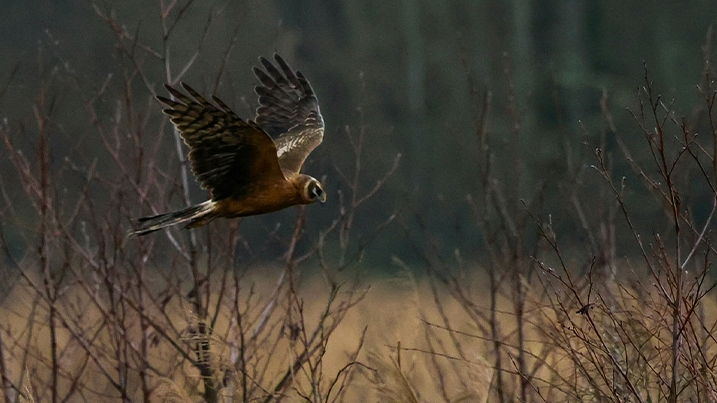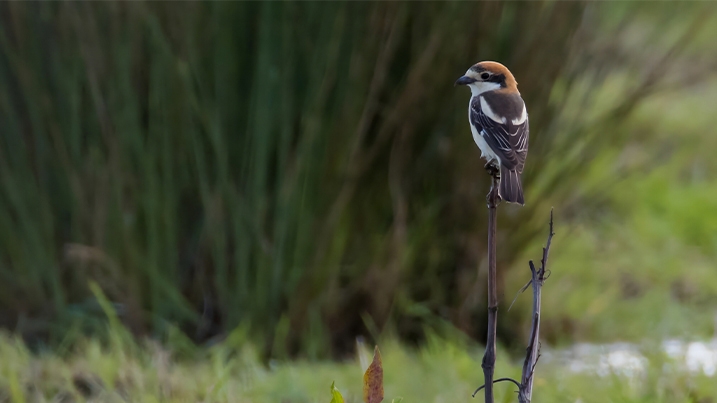Top 5 rare birds 2024
It’s been an unbelievable year for birdwatching at WWT’s wetlands this year. There’s been some dazzling rarities, with the list of sightings as long as a heron’s legs. But which birds have truly stolen the show?

As the year comes to a close, we ask one of WWT’s resident birders, Content Producer Sam Walker, to give us a rundown of his personal favourites.
Whether you’re a seasoned birder, or just here for the thrill of spotting something spectacular, get ready to meet our stand-out avian stars. And who knows – your next visit might bring a once-in-a lifetime sighting of your own.
5. A winter wonder: the juvenile pallid harrier
Kicking things off is a star of the saltmarshes - the juvenile pallid harrier that spent the winter exploring the River Lougher estuary, with Llanelli being a favourite haunt during its extended stay from December 2023 to April 2024. Will it return for an encore this year? Fingers crossed.
Pallid harriers breed in eastern Europe and central Asia, heading off to southern Africa or India for the winter.
But in recent years, they’ve started popping up in the UK, hinting at a potential eastward expansion. Some have even bred in the Netherlands and Spain.
While juveniles and females can sometimes be confused for other harriers, adult males are unmistakable, with their striking pure grey wings. Whether you spot a young adventurer or a mature beauty, this species never fails to impress.

4. A scarce shrike for Steart
Next up, let’s talk about the beautiful woodchat shrike that graced the wetlands of Steart Marshes for the first four days of May. Shrikes might be known as ‘butcher birds’ (yes, they hang their prey on thorns or even barbed wire!), but there’s nothing gruesome about this stunning visitor.
This adult was dressed to impress with its contrasting white, black and ochre plumage. Personally, I’ve only ever seen a juvenile, so this would be a plumage tick for me. Most woodchat shrikes spend their winters in tropical Africa and breed across southern Europe. But this bird took a detour on its northward migration, overshooting its usual breeding grounds. Lucky us!
As one of the scarcer shrikes to visit the UK, (after red-backed and great grey), this gorgeous guest caused quite a stir. But it doesn’t matter so much about the scarcity value – this was one lovely looking bird! Here's hoping for more unexpected appearances in the future.

3. Yellow-browed warblers: autumn’s little marvels
Third on my list is the yellow-browed warbler. Or rather, yellow-browed warblers plural. These small passerines are similar to chiffchaffs, but more brightly coloured green, with yellow markings.
If you visited WWT wetlands this October, chances are you might have heard their sharp ‘tsoo-eet’ calls or caught a flash of colour in the trees. These tiny Siberian migrants made their presence known in spectacular fashion this autumn. Usually found breeding in the Siberian taiga and wintering in south-east Asia, easterly October winds brought wave after wave of these warblers to the UK.
They arrived en masse on the east coast, then filtered through the country, with sightings at Slimbridge, Llanelli, Martin Mere and Caerlaverock. There’s still time to find one this winter, hanging out in the warmer, wetter, more insect-filled areas. One of the best ways to find one is to listen out for their distinct “tsoo-eet” call.

2. The elusive Savi’s warbler
In at number two, I’m going for one of the UK’s rarest breeding birds – Savi’s warbler. From 16th to 22nd June, this secretive singer turned Welney into a hotspot for birders hoping to hear its unmistakable high pitched, mechanical reel.
They’re closely related to the more familiar grasshopper warbler. Savi’s though, are true wetland specialists, only breeding in thick reedbed. They’re commoner across European wetlands, and winter south of the Sahara.
They’re not large, and they’re brown, so they can be difficult to pick out even with a telescope; but your ears will know when you’re near one.
With fewer than five pairs breeding in the UK annually, these birds are a rare gem, and Welney just might be worth a return visit next spring to see if they’re back. Volume up on the below to experience the magic of their song for yourself.
1. The Caspian tern double act
And now, drumroll please, my top rarity of 2024 goes to the two Caspian terns that wowed birders at Llanelli this spring. Again on the bird-magnet that is the River Loughor estuary, these two were present from 12th to 15th June.

Seeing one of these magnificent birds is thrilling enough, but two together? That’s a moment to remember.
With a wingspan rivalling a herring gull, these chunky terns are the giants of their family, rocking bold black crests and heavy red bills. Breeding populations are scattered worldwide, but the Caspian Sea is one of their key breeding areas.
They’re found breeding across much of North America and central Asia, migrating southwards to central America, Africa and India to spend the winter. Across China, Australia and New Zealand, populations are present all year-round. Young birds will often travel far and wide scouting out potential new breeding territories.
The closest breeding populations to the UK are in Sweden and Finland. Their growing presence in the UK hints at exciting shifts in their population, thought to be a direct result of these growing populations in Scandinavia.

They’re at my number one spot as they’re just so charismatic and a joy to see flying over a wetland, wherever you are in the world. They’re also large, easy to identify, and are so wide-ranging they could turn up at any wetland.
If you’re dreaming of a big find, keep your eyes peeled. These stunners are a realistic target for any UK birder next summer...
And that’s not all…
Above are my favourites, but there were so many more rare and scarce birds found at WWT sites this year, including:
Snow goose, red-breasted goose, American wigeon, green-winged teal, long-tailed duck, corncrake, purple heron, glossy ibis, spotted crake, white-rumped sandpiper, pectoral sandpiper, long-billed dowitcher, red-necked phalarope, white-winged black tern, wryneck, white-spotted bluethroat and great grey shrike.
What was your favourite bird of the year? Get in touch on our socials and share your pictures – we’d love to see them.
Header image – Caspian tern at Llanelli © Ruth Jones



